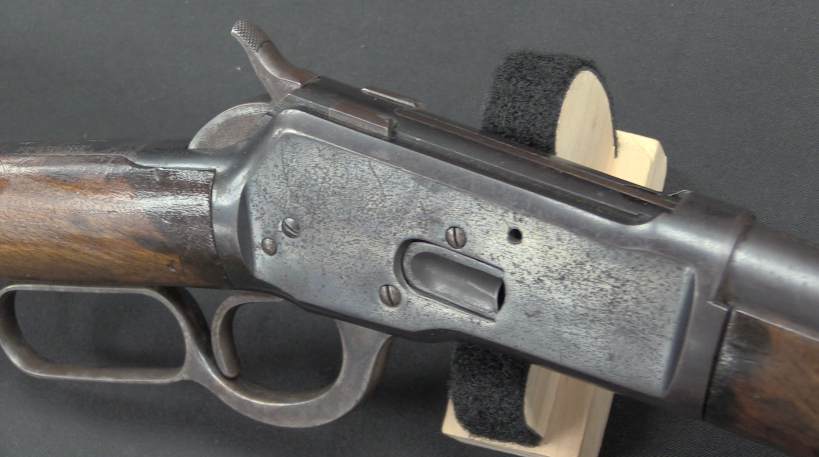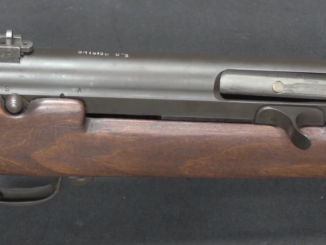The Ruger P85 – like so many of Ruger’s products – is not particularly attractive or exciting. It introduced no particular mechanical innovation besides the casting-based manufacturing that would actually probably be seen as a detriment if it were advertised. And yet, the gun (and those developed from it including the P89, P90, P91, and P94) were massively successful, with more than 700,000 produced. What Ruger did was to continue their standard operating procedure of making a gun that was practical affordable, and reliable without trying to make it flashy – and sold it by the boatload.
Related Articles

Lever Action Rifles
RIA: Spanish “El Tigre” Winchester 92 Copy
Spain was historically a major center of patent infringement in firearms manufacture because its patent law left open a big loophole: patents were only enforceable if the patent holder actually manufactured their guns in Spain. […]

Bolt Action Rifles
Atmed SMG and an Arisaka Addendum
First up today, we have some additional information on the scaled-down Arisaka trainer from our video on Monday. Teri from Nambu World gave us some more details (thanks, Teri and Chip!) that we would like […]

Prototype
Experimental Reising 7.62mm Full-Auto Battle Rifle
In the late 1950s or early 1960s, Eugene Reising experimented with adapting the mechanism of his submachine guns to a locked-breech 7.62mm NATO military pattern rifle. The resulting rifle used an M14 gas piston and […]

I refer to the P-89 as the “Sears Craftsman of handguns.”
Since we’re doing handguns in popular entertainment this week, I’ll note that in the “Empowered” comics by Adam Warren, one of the protagonists carries a boringly utilitarian P89. Warren has repeatedly lamented this choice on the grounds that it is a godawful design to draw realistically. So apparently Larry Larson’s aesthetic design work came up short in that one critical respect.
Ruger was not the first manufacturer to use cast parts in semiauto pistols – e.g. the CZ75 was introduced a decade earlier. They were pioneers in cast revolvers, though.
The CZ75, 1975 to 1980 (short rail) had a forged/milled frame and slide, that gained a semi-legendary reputation due to that.
Only in 1981 they introduced the cast parts.
So yes, cast CZ75 predates the P85, but not by much.
The P85 and its descendants were always guns you liked intellectually for all their good qualities and the sheer economy they presented, but… Man. Shooting them? Carrying them? Huge “Meh”.
I mean, I wanted to like them. I really did. But… I handled them, fired them, and they never, ever felt “right” in my hand. It was like holding a 2X4.
Guy I know who started his military and police career by serving as an armed security guy started out on a P-85; it was all he could afford, at the time. I am totally unclear on what led up to it, but the one “armed encounter” he had using it basically amounted to him substituting it for a piece of dimensional lumber and beating the crap out of his assailant with it. He never told me “the rest of the story”, but he got the pistol back from the cops after they’d kept it for a couple of years as evidence, and it still had the bloodstains and scrapes/scratches from where he’d used it on the guy. The poor thing was mostly inop due to blood in the frame/lockwork, and having been pounded up against pavement or concrete; in order to take it apart, we had to first lever the slide off the rails because the entire slide/frame was compressed where the baseball bat hit it. We thought. Might have been something else.
He confessed later that he didn’t remember anything about the attack, except that it happened, he didn’t get charged with anything related to it, and they’d kept his pistol for evidence. From the looks of that poor P-85, it had been a throwdown.
So, yeah… Apparently, you can beat someone near to death with a P-85. Never fired it, either… Whatever it was that hit that pistol, it had jammed the slide back just far enough that it was out of battery.
From the ones I handled, I found that it was reasonably reliable with FMJ standard-velocity 9mm, but not much else. Polishing or reconfiguring the feed ramp such as it was never seemed to do much good.
Accuracy was always in the “Minute of dinner plate at 50 meters” area. Meaning, you could hit a man in the chest with it that far away. At 100, groups opened to the level of a cacked-out WW2 M1911A1 at 200.
Ruger did a lot of “revisions” to the basic design, but they were mostly in the hope of getting military or LEO contracts. Meaning, going to DAO, decocker, and other trendy fashions as they developed, but not doing anything about the basic shortcomings of the original design. Like that horrendous grip, which I often suspected had been designed for a Deep One or maybe a nightgaunt.
Colt had a similar history with their Colt 2000 pistol, but they at least had enough sense to stop throwing good money after bad.
The P85 etc. series seems to have been Ruger’s one blind spot. Whether it was William B. Ruger’s personally or just their development and marketing departments’ generally, I don’t know.
Today it’s long gone and nobody seems to miss it much. Sort of the way I feel about the S&W Sigma in 9mm or .40 Auto either one.
But as Steve Jackson said about game design, to find out what the dumb strategies are, you have to test them. Otherwise you’ll never find out until it’s too late.
clear ether
eon
I never spent enough time with one to really wring it out, but I’m unsurprised. That swinging link design really almost mandates some form of hand-fitting and tuning it all, but the rest of the design is based on doing as little of that as possible…
The detailed records of the XM10 test are not public, but in the 1987 FBI test the P85 fared pretty bad.
Compared to SIG, Beretta, S&W and Glock, it ranked at the bottom in practically every respect (reliability, practical accuracy, ergonomy…).
So yes, it got a solid reputation as a “working man’s pistol” but, in the end, the other wondernines (to not say of the Glock) did it better.
Make mine the rounded-butt Ruger Speed Six stainless-steel .357 with a 2-3/4in. barrel, please. Six shots for sure.
The Postal Inspector guns were a lot of fun.
How was the P85s price tag, compared to other pistols of its era?
Dirt cheap. I remember seeing them new for around $250.00 and even less, when on some sort of promotional deal.
As I recall, the equivalent Glocks were going for around $350.00-400.00 at the time.
I have to admit to a certain appreciation for the P-85; it was a simple, durable 9mm for the commodity shooter, and if you were given a choice between a used P-85 and a new Hi-Point…? Take the Ruger.
i am looking for p89 or p85 ruger pistons
I was issued a P85 when they were new. The texture of the frame was so rough, it became very difficult to draw from our leather Safariland holsters. I negotiated with the Chief to provide my own pistol and swithced to a SiG 226. I assume the Ruger would have done the job, but I was VERY satidfied with the SiG.